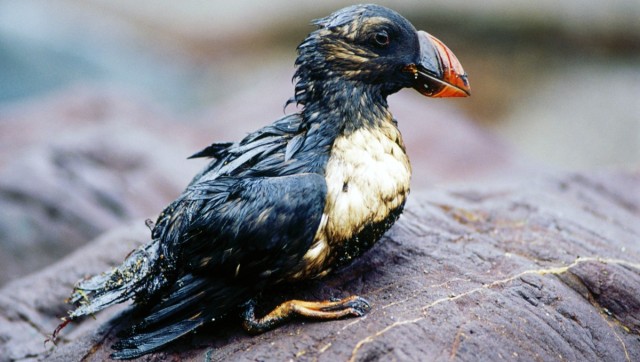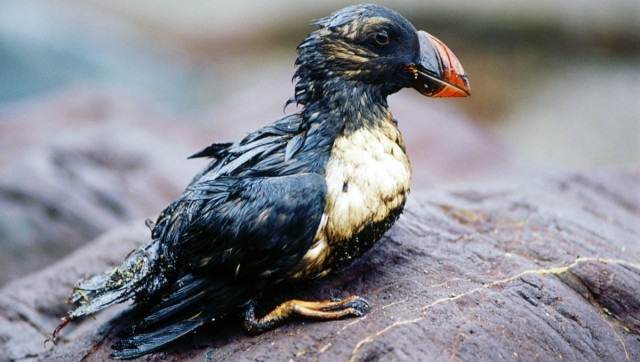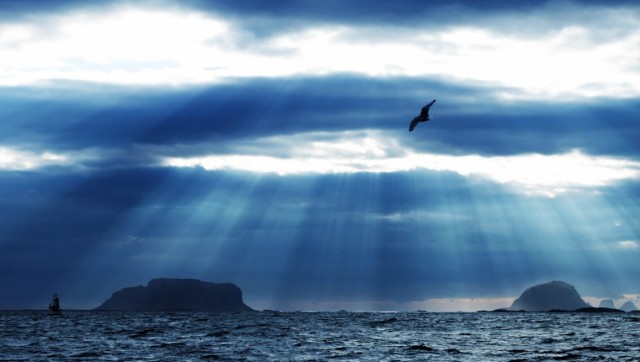Today it is 25 years since the Exxon Valdez. Experience shows long-term effects of the oil slick, in addition to the acute injuries. This will affect how we think about oil drilling in the North. After the Exxon Valdez, the world has also seen several major oil disasters, most recently in the Gulf of Mexico. In Norway, the cargo ships Full City and Godafoss run aground and shown that even small oil spills are difficult to handle.
Based on experience, new knowledge, and reports on the environmental risks associated with the petroleum industry and oil spill presents Naturvernforbundet here a day-by-day scenario for a hypothetical oil spill in northern Norway. At the bottom of the page you will find links to more information about lessons learned from the Exxon Valdez. Velbekomme, and let it not happen again!
Day 1, April 2025
An oil rig in Røstbanken has received a sharp kicks. Pressure in the reservoir has destroyed parts of the equipment, there is a gas alarm. The oil company tells the media that the rig is about to be evacuated, the production closed and there are no serious injuries. Coast Guard is on the way, and Nofo, the oil industry’s oil contingency has already vessels in the area.
Day 2: Government’s press conference. There is considerable confusion about the situation. From the public in small boats and fishermen are reports of an oil film on the water throughout the area towards Lofotodden and around seabird colonies on Værøy and Voice . Oil and environment ministers have canceled all appointments the next day to deal with the situation . The prime minister has “full confidence that safety is maintained and the responsible authorities are now making every effort to gain control of the serious situation . ” Oil rig is now without a crew on board and several remote systems are inoperative. The minister talks about full oil emergency mobilization. It is already laid out booms around the rig but little sign of oil. Oil Collector Ship is in place . Environmental organizations asking about the oil on the water toward Værøy and Rost may come from a subsea blowout. An environmental activist being ejected from the press conference after standing and waving an oil contaminated bird was picked up by the sea at Rost already day 1 We are working intensively to scout for oil slick from airplanes . The weather is good, but low pressure and powerful winds are expected into .
Day 3 : It blows up the air . NCA reports the work to soak up partly large oil slicks at sea and near shore . Petroleum Operating Scenarios are created , but it is uncertain whether the oil will hit the country . IUA – one , the inter-municipal pollution emergency action units are mobilized along the coast of Nordland and Troms. Lens Save and crew mobilized. The public is urged to stay away from areas with visible oil spills , and let be calling NCA switchboard capacity is blown .
Day 4 Morning News: The oil company holds a press conference . It has been used ROV around the drill site , and clear that it concerns a subsea blowout not unlike the Gulf of Mexico in 2010. There is uncertainty about how much oil runs out. It’s certainly about the largest oil spill in Norway in recent times. We work from the oil company to implement an operation to stop the blowout , but this will take several days or weeks to put in place .
The night wind and waves have swept large amounts of oil on land in exposed bays and coves on Voice and outside of the Moskenesøya . Viltnemdene are out and shoot the oil -damaged birds they find on land , in violation of the Environment Directorate directions that they should be collected before euthanasia . The crews in the field looks so much oil contaminated bird that collection is considered as totally unrealistic.
Civil Defence and NCA beach cleaning team is mobilized , but it is still uncertain where they should be inserted . The specially trained force is a total of 150 men . They can both suck up the oil from the sea in the bays and remove oil on land to prevent it taken by the tide and brought back to sea. Environment Directorate has asked that priority be given around the bird cliffs where large numbers of birds are collected and claims to have received the equipment in some bays.
Day 4 Dinner time : Environment Directorate has been birdwatchers out by helicopter over beaches and nesting . There are reports of a lot of oil , and the head of the directorate states that this is a huge environmental disaster. A number of large flakes are observed both inside and outside of Lofoten and runs fast with the coastal north and the country . The flakes moves above and below the water surface and the picture is very unclear . NCA and Nofo priority now is to try and capture the most close to the spill site , and to close off bays and inlets to harbors and vulnerable habitats .
Day 5 : Disaster is a fact and rolls in all media. It is believed to be a complete blowout that could potentially last for weeks. Heavy brown black waves rolling in oil on all exposed places in Lofoten and Vesterålen. More oil spill equipment is on track action centers , all local booms are already posted . There are problems with logistics in field action areas. All accommodation capacity is overloaded and Civil Defence set up tents for their people . Municipalities complain of confusion about who can get booms and that there are large amounts of unused booms in the central repository . A Lofoten mayor is outraged : ” I spend more time trying to find out who is responsible action management than on fighting the oil spill .”
Photos of oil contaminated puffins with the characteristic papegøyenebbene go worldwide . Ports of Lofoten and Værøy and Voice dotted oiled birds that are pressed into the fjord of oil and weather. Journalists from a number of countries are in place . Professionals dare not estimate how many thousands of birds that are already dead . There are estimated to be a few million puffins, as well as many other species , the areas which are now endangered . In the seabird colonies on the Voice tells ornithologists about horror scenes where over half of the birds they see with binoculars sitting and press inaccessible places up in the hills with clear oil spots on the plumage . Viltnemdene locally no longer has the capacity to take away avskytningen the injured bird. Several of the men have already been in fields around the clock for three days , bleeding nosebleeds and vomiting . They are strongly influenced by the experiences and needs rest .
Day 7 : A now near continuous oil slick spreads upwards along the coast and spill to every nook and cranny in the flow -prone areas . Local oil spill response crews are in full swing close to all coastal towns , blocking the strait and narrow fjord system so the oil does not get spread in there, but there is a lack of equipment.
From Central Europe are reports that large loads of cod and salmon received this week disposed to show consumers that it is not sold contaminated fish. Fisker teams now involved in assisting with the transportation of oil spill response crews and equipment into the affected areas. All commercial fishing and Fiskesalg in Nordland and Troms assessed stopped by Fisheries and Agriculture.
Day 8 : The Prime Minister is in place in Svolvær . And declared that all Coast Guard vessels and oil spill response vessels in the Nordic countries are in place or on the way . Specially designed ships to take up oil at sea are heading north from Spain and across the Atlantic from Canada and the United States . The vessels have experience from past disasters. Russia has offered the assistance of suitable vessels in its northern fleet and nuclear-powered icebreaker fleet , but the Norwegian government is awaiting the situation . Oil Minister is now leading a crisis team to stop the blowout , and try to find experts out there who can help. It is expected that the oil that has leaked will reach Tromsø and Finnmark coast in full if not many days , and it’s taken full alert there.
International environmental groups have gone out with a common requirement that all oil activity of Møre and north shut down temporarily. The main argument is that all the oil vessels and oil waste company now needed to deal with the oil spill . There is a great lack of other suitable vessel, and the capacity for storage of recovered oily water in the region is already blown . The government has rejected the proposal and instead requested a tanker that buffer pool .
Day 9 : Environment Directorate has considered urgent application by the NCA and the oil company about the use of chemicals to dissolve the oil slick , but has today rejected the application . Marine research was very negative because it is now in this area are large amounts of cod eggs high in the water that could be very adversely affected by chemical treatment of plumes of oil . In addition, one can not risk that oil after dispersion will sink down and lie on top of the large conserved coral reefs in the area. Bellona and Naturvernforbundet looking boat in the spill area says the basis of observations of water samples from different depths suspect someone already having tested a large amount of unknown chemicals to dissolve the oil. The suspicion is directed to supply the vessels that are able to bet around the rig site , and an American oil chemical supplier .
Day 12 : Most harbors , beaches and pier facilities in Lofoten and Vesterålen is full of major and minor oil slick that spill to vessels and equipment. Bad weather and power reduces the local oil link the effect to near zero. The oil flows both within and outside the booms.
Day 14 : The owners of a total of several hundred breeding cages in Nordland , Troms and Finnmark trying to move plants, but already coming oil after them rapidly and accumulate in quiet coves which are the mobile facilities’ places of refuge . The first plants obtained oil has started emergency slaughter by order of the FSA .
Scientists fear oil spill could be disastrous for a number of seabird populations . They recall that it should only be a small spot of oil on the plumage of feathers that the heat insulating capacity is considerably reduced so that the bird freezing to death by cold water from entering. They remind especially that dark death rates are large , as much dead bird disappears at sea or being taken by scavengers without ever being found and recorded. Several places along the coast there are reports now about eagles and fox sisters around the shoreline , obviously sick, poisoned by oil contaminated prey.
Day 15 : The oil has gone out from the shore at the South Island at a speed of 2 kilometers per hour. Finnmark cross your fingers and hold your breath . Marine scientist regret : It is natural, – the coastal current turns north here , but come back NE of the South Island near Hammerfest . South along the coast , it is now difficult to find birds that are not oily .
The massive popular mobilization and virtually emergency in coastal communities , where everyone contributes what they can to stop or clean up oil, is about to go into resignation and depression. It is difficult to see how it works. Even the Prime Minister has been on TV and expressed great frustration that the blowout is not yet stopped , and how powerless we are . The churches are open around the clock in several towns. People need a focal point.
The government promises that coastal communities should have the support they need to get back on their feet , but the priority date must be to stop the spill and limit the damage as possible .
Day 70: The blowout was stopped after 5 weeks and several unsuccessful attempts, and oil hit almost every vulnerable nature of locality as far north as Hjelmsøy in Finnmark. Prohibition on the sale of fish is lifted today . The ban on the sale of shellfish still apply. The fishermen’s organizations have asked the fishermen to wait until it is cleared with the government on the special compensation for whaling still continuing. You want a longer fishing moratorium until it is clear that there are some new flakes to the coast . Otherwise, it could harm the market’s perception of how clean the Norwegian fish are.
Day 80: Duck and auks which until now have survived the oil disaster is now entering a new katastrofetid . Now start moulting , ie moulting means that birds can not rise from sea level of 3-7 weeks. Auks located offshore and is prone to minor oil slick and thin oil film which still operates in this area . Ducks and geese congregate in concentrated moulting flocks in shallow waters along the coast. Environment Directorate notes that there is no area in western Finnmark suitable for the year and calls for volunteers nedskytning of injured and emaciated birds. Directorate will implement a pilot with the relocation of the rarest species , which has never been done in this country før.Naturvernforbundet in Østfold his project for the rehabilitation of injured wild oil in place for the job with expert teams, veterinarians and a container full of equipment. They began the laborious job of capturing and occupancy of rare bird species , one and one individual from one of the few fjords that is least loaded of oil . It is unclear where and when the birds can be released again .
1 year : Civil Defence volunteers and crew in the oil spill since the accident efforts to remove oil spill near towns and heavily used recreation and tourist places. Technical facilities at fish landing and ports are functional again . Cleanup crews , of which the majority of WWF’s beach clean- groups , have received no help of storms in winter on the vulnerable spots along the coast, but the shielded areas are still very soiled . In sheltered bays at the head of fjords see the seemingly good from a distance , but if one walks on the beach as you step through and get oil on the boots. Many of these will never be manually cleared, here you have to wait until nature has done the job in a few decades .
NCA , together with the Environment Directorate prepared an emergency plan for dealing with small oil slick which still operates in marine areas for the coming spring. These should be mocked and collected continuously.
Directorate has estimated these losses of seabirds in the first year :
– puffin 800,000
eider – 50000
– King Eider uncertain , probably 10,000
– Steller 5000 (including those who died of plumes of oil that drifted over to the Russian zone)
– guillemots 20,000
– shags and cormorants 7-8000
It is found 200 dead eagles and a handful of golden eagles .
The Directorate stated NO pup production of seals from Nordland and Finnmark last year when the areas where seals give birth was destroyed by the oil spill .
The same was true of birds residing in the beachfront in affected bays, not because nest sites was necessarily destroyed , but because it was not living life to eat on the beach.
No one knows what happened to whales and killer whales. Several oil spill sperm whale drifted ashore on Andoy in the summer but the cause of death is unclear. It is observed oil contaminated whales from planes and whale watching boats.
Aquaculture industry lawyers preparing insurance claims for several billion partly loss of equipment , production downtime and cleaning work.
Clean-up costs for coastal work , municipal authorities and private facilities as fish landing fast approaching ten billion. The government has guaranteed all over the state budget .
Norwegian authorities are considering how they legally should require reimbursement for both these cleanup costs , and unemployment benefits for thousands of workers in coastal fisheries , processing and aquaculture .
IMR can not yet say much about how the spill affected the fish stocks. It is highly probable that large quantities of fish eggs and fry that was high in the water simultaneously with the main discharge , have been affected.
The Norwegian fishing industry is struggling most with market credibility abroad even if all fish are now fully edible , and there are fish in the sea. The sale of Norwegian seafood abroad is less than half of before the accident and does not seem to pick up again . Several Chinese , German and American large buyers has completed its purchase agreements .




 In partnership turns the four bourgeois parties state that the waters off Lofoten, Vesterålen and Senja not be assessed in the next parliamentary term. Photo: Anita Arntzen / Dagbladet.
In partnership turns the four bourgeois parties state that the waters off Lofoten, Vesterålen and Senja not be assessed in the next parliamentary term. Photo: Anita Arntzen / Dagbladet.

